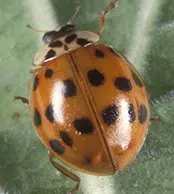You may have noticed a large number of, what look like, ladybugs in your home recently.
Looks can be deceiving. Chances are, they are aren’t your traditional lady bug, they are actually called the Asian Lady beetle. They have been found in New Brunswick for around ten years now.
Professor of Biology at UNB Steve Heard says they are looking for a place to go for the winter, “They are trying to find shelter, and in their native home, they tend to use crevices in cliff bases. Here in New Brunswick, they tend to fly around looking for a vertical wall with cracks in it, and they find your house.”
Heard says they are good ecologically, because they feed on aphids, and remove them from our gardens and fields, “But they are also bad for a couple of reasons as well. With the growing numbers, they could end up replacing our native ladybug. They also have a defensive behaviour when they are threatened, and can let off a foul smelling liquid, that can stain. We are also not big fans of them in our homes.”
Heard says some people say they also bite, but that is less common.
He adds, in an effort to control the large number of the home, many people just simply suck them up with a vacuum.
An interesting story as to how they came to be in Canada, Heard says, “Because of their usefulness for Agriculture, there were many attempts to introduce them in the US. Many state agencies tried to introduce them deliberately and repeatedly in the 1910’s, and again in the 60’s, 70’s, and 80’s there were many attempts to have them establish themselves here to help control aphids on crops. None of those attempts seemed to work. In 1988, we discovered a population of them in Louisiana. It appears they established there accidentally, after stowing away on a freighter. In only 30 years, they have spread, through all of the continental US, and the Southern parts of Canada. We have had them here in New Brunswick for around 10 years, I think. So it is interesting, and we don’t know why so many deliberate attempts failed, and then an accidental one took hold.”











